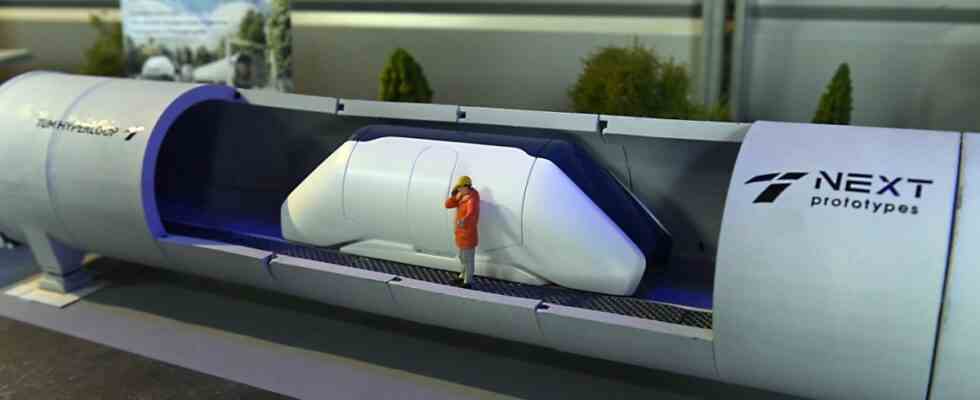Speeding through the area in a vacuum tube at 850 or more kilometers per hour and completing the Munich-Berlin route in just over half an hour: a vision that sounds more like a science fiction film than one that is to be expected anytime soon Revolutionizing transportation. But at the Technical University of Munich (TU) and especially at its innovative location in Ottobrunn/Taufkirchen, they firmly believe that the future belongs to the “Hyperloop” project. And because the Bavarian state government shares this optimism, they are already investing 3.5 million euros in the development of this magnetic levitation train as part of the Bavarian high-tech agenda. On Friday afternoon, Prime Minister Markus Söder and Science Minister Markus Blume (both CSU) came to the research site and picked up the spade: the symbolic start of construction for a 24-meter-long test track in the original scale, which will be built in the next few months.
Söder was in a good mood at his appearance in Ottobrunn, spoke of never having broken ground for such a short route, and has already announced that he will generously let his former Secretary General go first when the Hyperloop will one day be fully implemented : “First Markus Blume drives and when he has survived it, I drive too.” Meanwhile, the local big names of the Christsoziale were conspicuous with their absence: neither the member of parliament Florian Hahn nor the former Bavarian Minister of Transport Kerstin Schreyer came to this prestigious appointment for the high-tech location in the south-eastern district of Munich. But Munich’s second mayor Katrin habenharm (Greens).
“This is a day that gives utopian courage in dystopian times,” says Söder
And so it was left to the Prime Minister in particular to describe the Hyperloop as the “next step into the future”, even if it is not yet entirely clear what mobility will actually look like in the coming decades: “We’re just around the corner, see the light shine through below, but we don’t yet know how to open them and what we see behind them,” said Söder, praising the free research in Germany, the teamwork as the basis of research at the TU and the willingness to develop new business ideas: “The is a day of utopian courage in dystopian times.”
The ground-breaking ceremony for the test track in Ottobrunn was held by TU employee Raphaela Schiburr, Science Minister Markus Blume, Prime Minister Markus Söder, TU Vice President Gerhard Kramer and project manager Gabriele Semino (from left).
(Photo: Claus Schunk)
Söder’s prognosis that the research project is an opportunity to “soon” be able to get from the city to the airport or the exhibition center in no time at all should be extremely optimistic: the next step is to build a one-kilometer test track by 2025, the project manager added Gabrielle Semino. He heads a team of 86 students from 28 nations that emerged from an initiative founded in 2015 with the aim of taking part in the SpaceX Hyperloop competitions that Tesla boss Elon Musk launched with his space company. Since then, the TU troop has taken first place in all four competitions and set a world record with their simulation, in which the suspension railway reaches 482 kilometers per hour. All of this also commands respect from Söder: “You know it from football: It’s easy to win once. But more often, that’s the great art.”
A concrete tube with a diameter of 4.2 meters and a capsule for the passengers are being built in Ottobrunn
Project manager Semino sets the direction: “We are pursuing two goals: On the one hand, the technology has to be developed and on the other hand, we have to develop Europe-wide route networks as part of a concept analysis.” In concrete terms, a test facility will now be created, a so-called demonstrator, consisting of three components: a concrete tube with a diameter of 4.2 meters, in which the main focus is on researching the seal, since the Hyperloop system is based on an almost vacuum; a capsule for the passengers, whose safety should be the focus of the development; as well as an operational control system, i.e. the control of the tube, capsule and drive. “So far there has only been one tube in Garching, but it’s very small,” explains Dominik Radeck, Hyperloop’s Technical Director. “Now we’re getting them in the right scale for the first time.” The scientist is almost euphoric, after all he has been working on the project “for ten years”. “Together with politicians, universities, industry and a bunch of over-motivated people, we can make it a reality.”
This is what the test facility near Ottobrunn should look like.
(Photo: Claus Schunk)
This is what the concrete tubes could look like.
(Photo: Claus Schunk)
A model of the passenger capsule.
(Photo: Claus Schunk)
With all the optimism, however, there are still a few difficulties to be overcome – and this does not even mean the acquisition of land for a possible route or the procurement of raw materials for the construction of longer routes. It’s about making this type of locomotion safe, because a sudden drop in pressure due to air intake at such high speeds would result in devastating accidents. Therefore, according to project manager Semino, more work needs to be done on this point. “Regardless of the means of transport, whether car, plane, bus or train – there are risks everywhere. Our task is to reduce them.” After all, you don’t want to be stuck in the same traffic jams in “20 or 30 years as you are today”.

